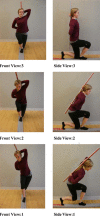Relationship of the functional movement screen in-line lunge to power, speed, and balance measures
- PMID: 24790688
- PMCID: PMC4000474
- DOI: 10.1177/1941738114522412
Relationship of the functional movement screen in-line lunge to power, speed, and balance measures
Abstract
Background: The in-line lunge of the Functional Movement Screen (FMS) evaluates lateral stability, balance, and movement asymmetries. Athletes who score poorly on the in-line lunge should avoid activities requiring power or speed until scores are improved, yet relationships between the in-line lunge scores and other measures of balance, power, and speed are unknown.
Hypothesis: (1) Lunge scores will correlate with center of pressure (COP), maximum jump height (MJH), and 36.6-meter sprint time and (2) there will be no differences between limbs on lunge scores, MJH, or COP.
Study design: Descriptive laboratory study.
Level of evidence: Level 3.
Methods: Thirty-seven healthy, active participants completed the first 3 tasks of the FMS (eg, deep squat, hurdle step, in-line lunge), unilateral drop jumps, and 36.6-meter sprints. A 3-dimensional motion analysis system captured MJH. Force platforms measured COP excursion. A laser timing system measured 36.6-m sprint time. Statistical analyses were used to determine whether a relationship existed between lunge scores and COP, MJH, and 36.6-m speed (Spearman rho tests) and whether differences existed between limbs in lunge scores (Wilcoxon signed-rank test), MJH, and COP (paired t tests).
Results: Lunge scores were not significantly correlated with COP, MJH, or 36.6-m sprint time. Lunge scores, COP excursion, and MJH were not statistically different between limbs.
Conclusion: Performance on the FMS in-line lunge was not related to balance, power, or speed. Healthy participants were symmetrical in lunging measures and MJH.
Clinical relevance: Scores on the FMS in-line lunge should not be attributed to power, speed, or balance performance without further examination. However, assessing limb symmetry appears to be clinically relevant.
Keywords: limb dominance; screening; symmetry; unilateral.
Conflict of interest statement
The following author declared potential conflicts of interest: Erin Hartigan received a grant and consulting fees or honorarium from UNE.
Figures
References
-
- Baechle TE. Essentials of Strength Training and Conditioning. Champaign, IL: Human Kinetics; 2008
-
- Butler RJ, Plisky PJ, Southers C, Scoma C, Kiesel KB. Biomechanical analysis of the different classifications of the Functional Movement Screen deep squat test. Sports Biomech. 2010;9:270-279 - PubMed
-
- Chapman RF, Laymon AS, Arnold T. Functional movement scores and longitudinal performance outcomes in elite track and field athletes [published online April 23, 2013]. Int J Sports Physiol Perform. - PubMed
LinkOut - more resources
Full Text Sources
Other Literature Sources
Research Materials
Miscellaneous


